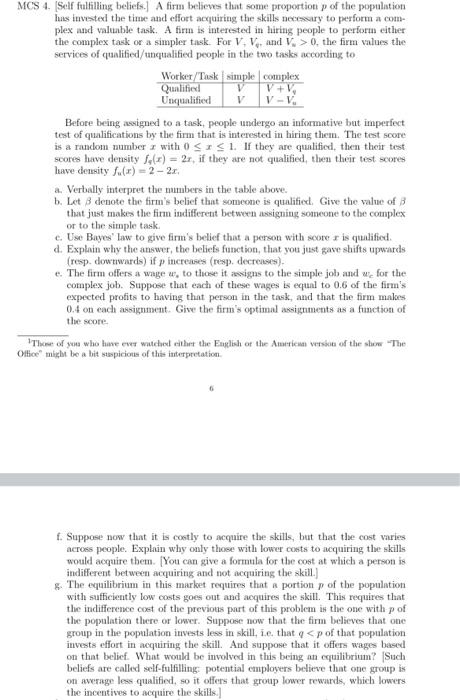Question
Hi, please help. thanks! V V MCS 4. Self fulfilling beliefs. A firm believes that some proportion of the population has invested the time and

0, the firm values the services of qualified/unqualified people in the two tasks according to Worker/Task simple complex Qualified V + V Unqualified V-V Before being assigned to a task, people undergo an informative but imperfect test of qualifications by the firm that is interested in hiring them. The test score is a random numbers with 05:51. If they are qualified, then their test scores have density felt) = 2x, if they are not qualified, then their test scores lave density f(x) = 2 - 2 a Verbally interpret the numbers in the table above. b. Lat 3 denote the firm's belief that someone is qualified. Give the value of B that just makes the firm indifferent between assigning someone to the complex or to the simple task c. Use Bayes' law to give firm's belief that a person with scorer is qualified d. Explain why the answer, the beliels function, that you just gave shifts upwards (resp. downwards) if p increases (resp. decreases). e. The firm offers a wage w, to those it assigns to the simple job and wie for the complex job. Suppose that each of these wages is equal to 0.6 of the firm's expected profits to having that person in the task, and that the firm makes 0.4 on each assignment. Give the firm's optimal assignmetits as a function of the score. The of you who have ever watched with the English or the American vetskit of the show "The Office" might be a bit spicious of the interpretation f. Suppose now that it is costly to acquire the skills, but that the cost varies across people. Explain why only those with lower costs to acquiring the skills would acquire them. You can give a formula for the cost at which a person is indifferent between acquiring and not acquiring the skill.) The equilibrium in this market requires that a portion of the population P with sufficiently low costs goes out and acquires the skill. This requires that the indifference cost of the previous part of this problem is the one with p of the population there or lower. Suppose now that the firm believes that one group in the population invests less in skill, i.e. that q
Step by Step Solution
There are 3 Steps involved in it
Step: 1

Get Instant Access to Expert-Tailored Solutions
See step-by-step solutions with expert insights and AI powered tools for academic success
Step: 2

Step: 3

Ace Your Homework with AI
Get the answers you need in no time with our AI-driven, step-by-step assistance
Get Started


